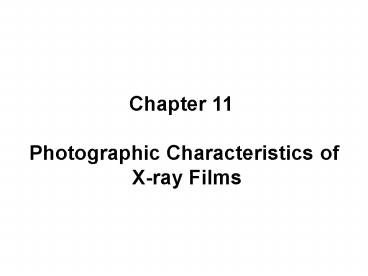Photographic Characteristics of - PowerPoint PPT Presentation
1 / 17
Title:
Photographic Characteristics of
Description:
Density is expressed as a number that is actually a ... Emulsion Absorption ... Emulsion Absorption (cont.) Green-sensitivity film is called ortho film. ... – PowerPoint PPT presentation
Number of Views:111
Avg rating:3.0/5.0
Title: Photographic Characteristics of
1
Chapter 11 Photographic Characteristics of
X-ray Films
2
Photographic Density
The measurement of film blackness is called
photographic density usually, only the word
density is used. Density is expressed as a
number that is actually a logarithm, using the
common base 10.
Density D density I0 light
incident on a film It light
transmitted by the film
3
Opacity (????)
measures the opacity of the
film. Opacity is the ability of film to stop
light.
4
Transmittance (???)
measures the fraction of light transmitted
by the film.
5
Density Range
- Useful densities in diagnostic radiology range
from about 0.3 (50 of light transmitted) to
about 2 (1 of light transmitted). - Higher density means a blacker film.
6
Characteristic Curve
- The relationship between the exposure and density
is usually plotted as a curve, known as the
characteristic curve or H and D curve (named
after F. Hurter and V.C. Driffield).
- Here, exposure means the product
- milliamperes of x-ray tube current (mA)
- and time of exposure (seconds).
- Therefore, exposure is expressed in
- terms of mAs.
7
Purpose of Using Characteristic Curve
- Analysis of the characteristic curve of a
particular x-ray film provides information about - the contrast of the film,
- the speed (sensitivity) of the film, and
- the latitude of the film.
8
Contrast
- The subject contrast depends on the differential
attenuation of x-ray beam as it passes through
the patient. - (Subject contrast is affected by the thickness,
density, and atomic differences of the subject,
the radiation energy (kVp), contrast material,
and scatter radiation.) - The film contrast is considered as how the film
responds to the difference in exposure produced
by the subject contrast. - The radiographic contrast depends on the subject
contrast and the film contrast.
9
Film Contrast
- The film contrast depends on the following
factors - slope (or gamma) of characteristic curve of the
film - film density
- screen or direct x-ray exposure
- film processing
10
Film Contrast - Slope of Characteristic Curve
- Film gamma is defined as the maximum slope of the
characteristic curve, and is described by the
formula
where D2 and D1 are the densities on the steepest
part of the curve resulting from log relative
exposures E2 and E1, respectively.
11
Film Contrast - Slope of Characteristic Curve
(cont.)
- The slope (gradient) of a straight line joining
two points of specified density on the
characteristic curve is called average gradient. - The average gradient is
- usually calculated between
- density 0.25 and 2.0 above
- base and fog for radiographic
- films.
- If the average gradient of the
- film is greater than 1, the film
- will exaggerate subject contrast.
12
Film Contrast - Film Density
- The slope of the characteristic
- curve (i.e. film contrast)
- changes with density.
- This is especially true in
- the toe and shoulder regions.
13
Speed of Film-Screen
- The speed of a film-screen system is defined as
the reciprocal (??) of the exposure in roentgens
required to produce a density of 1.0 above base
plus fog density.
D 1 0.3 1.3
0.57mR
14
Speed of Film-Screen (cont.)
Film A
Film A
Density
Density
2.0
1.5
Film B
1.0
Film B
1.0
Log Relative Exposure
Log Relative Exposure
The speed of film A is faster than film B.
The speed of film B is faster than film A.
15
Latitude of X-ray Films
- Latitude refers to the range of log relative
exposure (mAs) that will produce density within
the accepted range for diagnostic radiology
(usually considered to be density 0.25 to 2.0.) - Generally speaking, the latitude of a film varies
inversely with film contrast.
16
Emulsion Absorption
- Standard silver halide films absorb light in the
ultraviolet, violet, and blue regions of the
visible spectrum.
17
Emulsion Absorption (cont.)
- Green-sensitivity film is called ortho film.
- Red-sensitivity film is called pan film.































